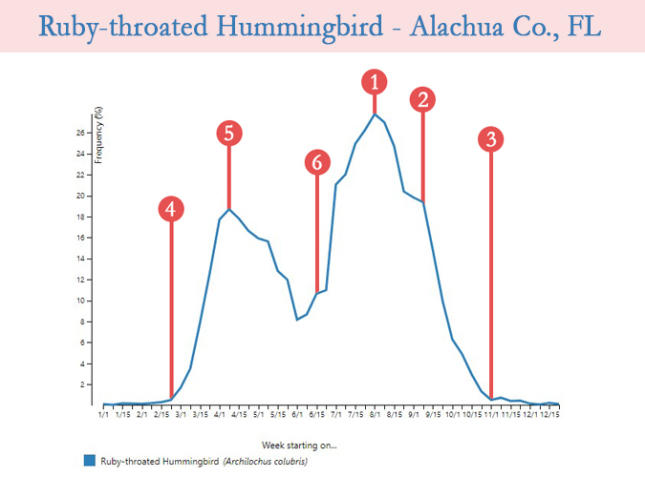This is why you leave a hummingbird feeder up all year long

Jump to point 4 because it's now early March and we are already seeing the return of Ruby-throated Hummingbirds (RTHU) from their overwintering grounds in Mexico and Central America. Follow along in order as I explain how this chart shows you everything you need to know about the status and distribution of the RTHU in Alachua County, FL over the course of a year. I wrote this article on September 7, 2020. That's why Point 1 is where it is.
Point 1
The first week of August is actually the peak of Ruby-throated Hummingbird season in Alachua County, FL in terms of the frequency of reports that contain at least one RTHU. Refer to the y-axis for that actual value (27.77%).
Point 2
Migration is already waning at this point around mid-September but this little hump is here because RTHU is heavily affected by weather conditions in the Gulf of Mexico. If weather isn't favorable for migration, birds tend to bottleneck in the peninsula. In the last decade, this has happened significantly and frequently in the first two weeks of September. Bottlenecking has brought the frequency of RTHU observed in the county up in this time period.
Point 3
Trans and circum-Gulf migration has all but ended by late October but note that the frequency of birds observed in the county never goes all the way to zero. There are always at least a few birds that remain after the vast majority has flown across the Gulf and movement continues throughout the winter. Some overwintering birds remain at one location all winter long. Others are only seen once and seem to move on. Many others exhibit a pattern somewhere in between, showing up for a few weeks, a month, or a little more and not seen before or after.
Point 4
The first apparent trans-Gulf migrants returning from overwintering grounds in Mexico and Central America begin showing up in the county as early as the last week of February. Follow the slope up a little bit further from point 4 and you'll note that your first birds are probably somewhere in that range of dates.
Point 5
The peak of spring migration occurs at about the second week of April. Numbers begin to wane at this point and many back yards go from seeing multiple hummingbirds all day long every day to seeing a hummingbird or two a few times a week. Those of you who are lucky enough to have a nest nearby may have daily activity but many back yards in peninsular Florida are very slow for the rest of the summer after this point.
Point 6
Post-nesting dispersal and the beginning of fall migration. The slow period begins to end around mid-June every year as young birds have fledged and are now foraging independently and southward movement off of breeding grounds further north in the range begins. The breeding range of the RTHU is well up into Canada and density is much greater in most of the range than it is in Florida. So, there are a lot of birds that have to move through as almost every bird in the species ends up in Mexico and Central America for the winter. That's why the fall migration lasts about four months. Note* - After about the third week of August, you're seeing new hummingbirds almost every day. Most of the birds visiting your feeder are not sticking around. They're paying short visits and being replaced by new birds as migration continues like a conveyor belt.

